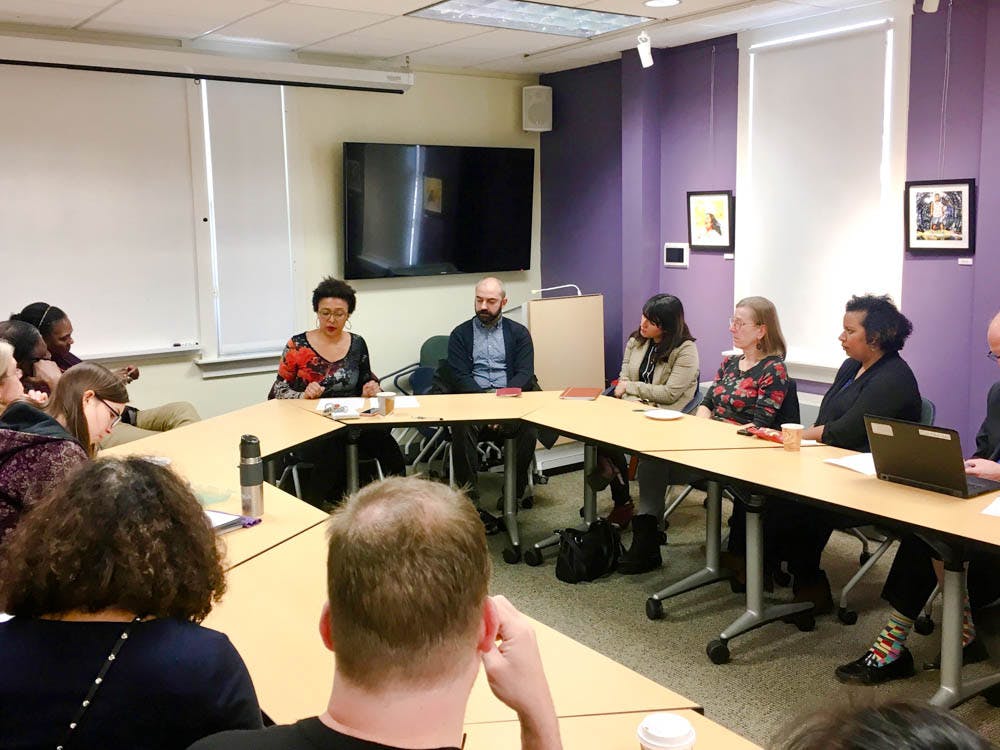While it is unusual for drama clubs and the crisis of mass incarceration to share ground in a line of inquiry, Assistant Professor of Africana Studies Lisa Biggs spoke about the nexus of the two during a presentation Tuesday.
Biggs’ work investigates the impact of theater programs for incarcerated women and was the focus of her talk in the ongoing “What I Am Thinking About Now” series, which is hosted by the University’s Center for the Study of Race and Ethnicity in America. Biggs’ talk included a reading from her forthcoming book on the role of the arts in “rehabilitative” prison programming for incarcerated women, who represent the fastest-growing demographic of the United States’ prisoner population.
Biggs described her book as a “combined ethnography-historiography about four theater programs for women who are incarcerated,” which emphasizes instances of black feminist theater. Black feminist theater features “black women’s stories at the center of the narrative,” which she considers especially important in light of the often racist, classist backgrounds of historical feminist movements, she said.
“It’s a chance to engage with your interior landscape as an artist,” Biggs said of the theater programs, adding that engagement in black feminist theater in particular often involves an “ethos of caring.”
Biggs’ talk brought to light the fact that the crisis of mass incarceration has left black women disproportionately stuck in jails. She cited the low median income of black women and noted how it can cause problems for those who have struggled with addiction. Often, these women are financially unable to continue treatment outside of the “28-day programs” of detoxification that are sometimes offered inside of prisons. Black women unable to pay their bail have a median income of just over $9,000, which the ACLU reports is nearly five times less than the median income of non-incarcerated white men.
“Our prisons are for punishment,” Biggs said, criticizing the fact that facilities are not designed to truly rehabilitate their inmates. She described the prison system as intended to “contain and immobilize people who we think are problematic,” adding that “they are not for helping people.”
Biggs focuses her energy on answering the question of how theater can make a difference in a moment of crisis for a broken system. She described the final decades of the war on drugs and how it aimed to undermine the
“urban communities that had previously been engaged in Civil Rights, Black Power” and similar movements. In those years, artistic expression played a role in “transforming the culture,” she said.
“This work with people behind bars is an extension of the whole Black liberation struggle,” she added, noting that artists have been working with criminalized communities for a long time. “In some ways it’s not new; what is new is the number of people behind bars.”
Professor of Sociology and Africana Studies Paget Henry attended Biggs’ talk and said that while he was knowledgeable about some of the problems involved, the presentation was still informative. “The fact that (mass incarceration) disproportionately affects peoples of African descent is a major concern,” he said. “But the big thing for me personally was the statistics on female incarceration that the talk revealed.” He was struck by the undifferentiated nature of prison environments regardless of the crime and that some of those who go to prison have been falsely accused. “It’s hard to imagine something worse than … being imprisoned for a crime you didn’t commit.”
The question of whether the arts can be truly “healing” brought about a lively conversation after Biggs’ talk, as some in the room raised doubts about the usefulness of thinking about art or theater in a clinical context. Biggs holds no illusions that theater can take the place of real systemic change or rehabilitative efforts. However, she described inmates as finding the programs “life-affirming,” a consequence of the fact that few other spaces are “meant to be a dialogue” in the way that theater is intended. “It’s not therapy, but I think it can be therapeutic,” she said.





